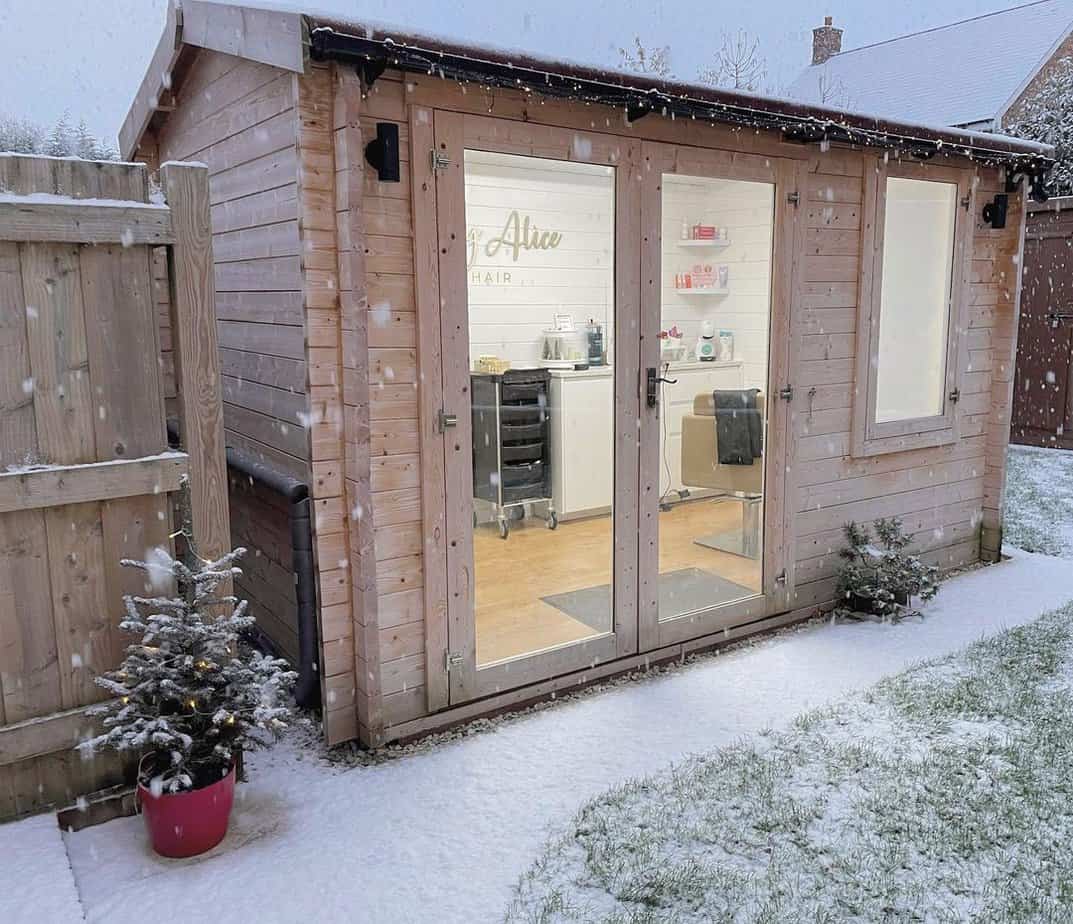Jump to:
Garden log cabins have thick walls, so they should stay warm, especially when the logs are as thick as 28mm or more. But cold air can still sneak in through gaps and corners. If yours feels drafty or you want to stop that before the colder months, here’s how to keep a log cabin warm in winter.
Still shopping for your new cabin? Check out our log cabin buying guide to make an informed decision.
How to Keep a Log Cabin Warm in Winter
(Customer’s image: BillyOh Devon Log Cabin with 44mm log thickness)
Even doing just one tip from this list can make a difference to how you spend time in your garden retreat.
Fix roof leaks by sealing the gaps
Cold air sneaks in through gaps, cracks, and weak panels, but you can stop it. Replace or patch any damaged sections of roofing felt and use sealant on exposed areas. Include the gutters in your inspection; clear and remove moss to avoid water pooling.
If your roof consists of some boards and felt on top, you might be able to insulate it by fitting a layer of insulation material (such as foam or mineral wool) under the roof boards to trap more heat. This can then be locked in place with some added panelling. Be sure not to block airflow to any vents you may have installed. Vents often have flashing around them to help keep gaps sealed — ensure these are nice and tight.
Seal doors and windows
The windows and door we rely on to keep out the cold can be the reason the cabin feels freezing inside. Chances are, there are openings. Fit draught excluders along door edges and add foam tape. Proceed to the corners and joints with an exterior-grade silicone.
Optional, but hang thermal blinds to windows for extra protection against the chill.
Layer up the walls and roof
Thick walls do a lot, but then again, heat still finds its way out if gaps or thin spots remain. Upgrade the wall panels with extra foam boards or reflective panels to trap more heat. For the roof, fit insulated panels or squeeze in a layer of felt under the existing roofing.
You don’t need to take the walls or roof apart to do this. Remember that if you’re fitting permanent insulation, this is a modification that could affect your building’s warranty.
Insulate the floor
The floor can be the culprit, too! Even if your walls and roof are sealed, cold creeps up from below. Lay insulation mats or carpet underlay to trap that chill before it spreads. Another trick is to cover the spots you spend the most time standing or walking on with a rug.
At the stage of putting together floorboards, underfloor heating could work. This guide can help you with that: Can You Install Under Floor Heating in a Log Cabin
Turn on the heater
With the log cabin already sealed and layered for warmth, it’s time to bring the heater. For a small cabin, stick with an oil-filled radiator or electric heater to heat the space evenly.
A wood-burning stove suits larger cabins if the floor and ventilation are safe. Portable propane heaters are also helpful for corners – just take care with indoor safety. If you’re considering any of these two, get more tips here: Installing a Wood Burner in a Shed
Getting your log cabin winter-ready is easier than it sounds. Check the roof, seal gaps, boost insulation, and get heating sorted. Follow these tips and you’ll stay warm and cosy all winter.
If you’re still in the market for your garden building, it’s worth noting that the warmest options are pre-insulated garden rooms.
FAQ
Do I need a special floor under the cabin to keep it warm?
No, you don’t need a special floor. Adding insulation mats or carpet underlay is enough to provide some surface insulation to keep your feet warm, as a temporary solution.
Will sealing the log cabin doors and windows completely stop drafts?
No, not always. Even after draught-proofing, tiny gaps can remain. Check corners, joints, and use silicone sealant or thermal blinds to block the last bits of cold.
Should I move furniture away from heaters?
Yes, because a heater needs space to push warmth into the room. If furniture sits in front of it, the heat will be blocked, and it will take longer to warm the whole space. Keep furniture a little away, just enough so it’s not obstructing the heater.






